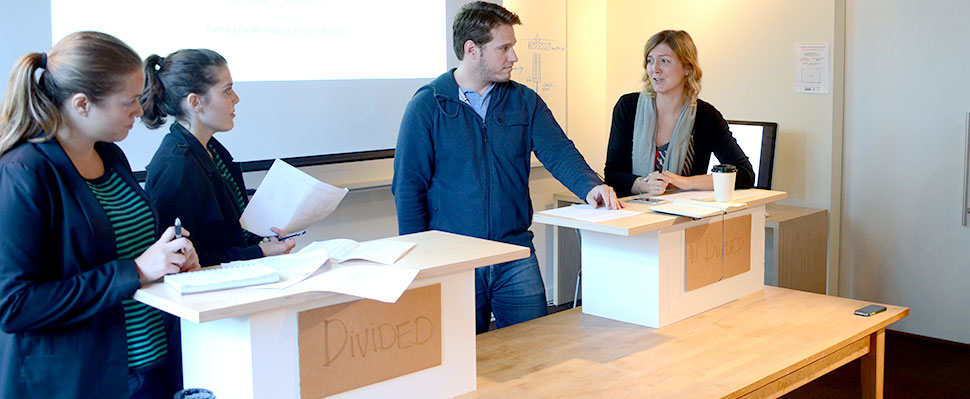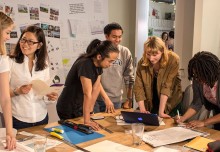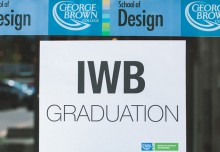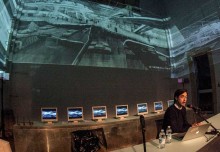Debate! “Be it resolved that the city of Toronto is politically divided.”
The first of three student debates happening as part of the Design Issues course
On Thursday September 25th as part of the Design Issues course, the IwB students partook in their first debate. These debates are meant as an opportunity for students to engage more fully with all the materials and information they are reading as part of their major project, Connecting Divided Places, as well as find their own voice in argumentation and current civic discourse. This week, a group of four debaters (with a big thank you to Magda who joined from the IwB team) debated; “Be it resolved that the city of Toronto is politically divided.
To give you a taste of the arguments, we offer you some of the highlights!
PRO- Marta Pierdras & Luiza Albertini
CON – James Young & Magdalena Sabat
Marta Piedras kicks off the debate with the PRO argument.
Good morning, fellow debaters, audience. Thank you all for coming here today. My name is Marta Piedras and she is my colleague Luiza Albertini. We are both immigrants from different countries and we have been living in this city for two years. In the beginning, we didn’t see the divisions that exist in Toronto. However, when we start to observe this city, we begin to understand the magnitude of the issues that fragment the city of Toronto.
We are here to defend our position in favour of the statement that Toronto is a politically divided city.
But that would be to easy, because, isn’t it within the essence of democracy to represent the people with different opinions, cultures, interests, and concerns? We could argue that everybody wants well-being, safety, and stability, but is the way to achieve these goals where we found the discrepancies.
How could the fifth-most populated city in North America, with 2.6 million residents, not be politically divided?
It’s what lays underneath these divisions that really concern us today. The political divisions of our city are just the top of the iceberg reflecting major issues that are segmenting Toronto.
Then James Young and Magda Sabat set the tone for their CON argument.
One thing I would encourage you and my colleagues to not confuse is political diversity with political division. We’re going to outline a case where we show that amalgamation in 1998 has made the city cleaner, safer, and more fair.
We’re going to show you that entering the political process and participating in the political process in this city is very accessible, and encouraged, as well as there being programs in place to support this participation. We’re going to show you that the citizenry is able to enact policy change and this is an indicator of a very healthy and engaged democracy. We’re also going to show you that the council does not act unilaterally, that there is dissent and there is also consensus. We are going to show that the idea of the inner suburbs of Toronto being a single homogenous entity is entirely false, and the fact that Ford Nation thrives there is an indicator of solidarity, not division.
We are going to talk a lot about the difference between division and diversity and the fact that Toronto is one of the most diverse cities in the world. It is one of the cleanest cities in the world, it’s one of the safest cities in the world, and it’s one of the most accessible cities in the world. Hence, why we have so many immigrants constantly—I’m an immigrant as well—and why so many people come here and want to make it their home.
It is not a coincidence that Toronto is on a high scale of cities where people want to live. People come here to not only join a new civil society that they feel is fair and can provide a good home for their families, they come here for service access, right? They know that if they live in Toronto that their trash will be collected. They know that they’re safe to walk on the street. They know that their kids will have access to education and all types of special education programming, whether their kids have a type of disability or have a particular skill and want to go to a special sports or arts school. These are all things that are part of Toronto.
After some heated back and forth during an open debate segment, each team wraps up their arguments, starting with Marta and Luiza.
To sum up, folks, the public policies can change this situation by providing affordable houses to low-income households, expanding access to transit and services in neighbourhoods.
And, as Joshua Kertzer and Jonathan Naymark said, “The answer is finding a leader who can connect with all regions of the city.” It is still not here.
But, it cannot achieve its potential with its citizens and politicians locked up in silos. The more connected it is—physically, economically, and, especially, politically—the easier it will be for citizens and businesses to succeed within it. But not only citizens; every single person in this city. Permanent residents and immigrants who also live in this city and pay the taxes.We love the city and the people who live here. We believe that everyone counts. Every neighbourhood counts. Let us commit together to achieve the original spirit of Toronto: “Diversity, our strength.” Not our weakness. Because only working together with our common faith will we make the city that we dream of.
The “Three Toronto’s” can become one.
The time to act is now.
Finally the argument was followed by James and Magda.
Thank you, again. Let us sum up by reiterating that Toronto is cleaner, safer, and more fair because of the unity amalgamation brought about in 1998. The inner-suburbs are thriving. They are not this ghettoized land of angry, poor immigrants, as our opponents might suggest. Ford Nation is a very diverse place. It is not this stereotypical angry, republican, affluent, white-collar person. You’ve got middle class, you’ve got very affluent people, you’ve got first-generation immigrants, and visible minorities. And these people all came together because this one person connected with them. And I don’t know if there’s a politician in recent memory who’s touched more people than Rob Ford has. We don’t all want to agree. That sort of uniform opinion is dangerous. And we want to make sure these dissenting voices are heard.
A charming example of how distorting, bending and stretching facts and reality can make for a thought-provoking and convincing argument. We look forward already to the next debate coming up in a few weeks.
Stay tuned!



